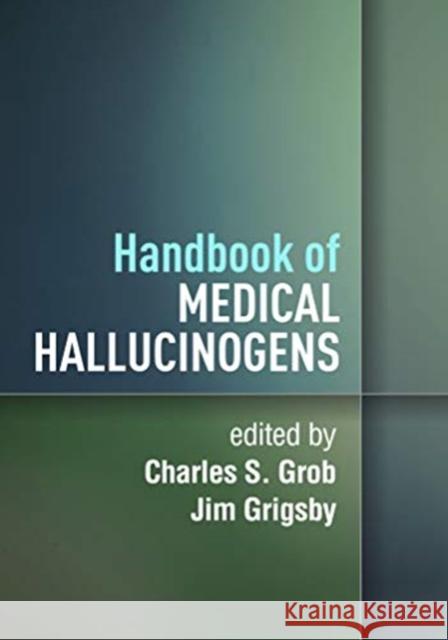Handbook of Medical Hallucinogens » książka



Handbook of Medical Hallucinogens
ISBN-13: 9781462545445 / Angielski / Twarda / 2021 / 582 str.
Handbook of Medical Hallucinogens
ISBN-13: 9781462545445 / Angielski / Twarda / 2021 / 582 str.
(netto: 370,07 VAT: 5%)
Najniższa cena z 30 dni: 287,08
ok. 22 dni roboczych
Dostawa w 2026 r.
Darmowa dostawa!
This state-of-the-art handbook reviews promising applications of psychedelics in treatment of such challenging psychiatric problems as posttraumatic stress disorder, major depression, substance use disorders, and end-of-life anxiety.
"If you’re looking for a comprehensive work on hallucinogens, this is it! This book can benefit all, from novice to expert. Grob and Grigsby take the reader on a journey through all aspects of medical hallucinogens, including their neuroscience, therapeutic considerations, and more. The book dives into individual hallucinogens and incorporates contributions from leading experts in the field. This is the ideal reference and text for the current renaissance of psychedelic research."--Rick Doblin, PhD, Executive Director, Multidisciplinary Association for Psychedelic Studies
"This volume is a wide-ranging, interdisciplinary, state-of-the-art overview of the powerful and curious chemicals variously known as hallucinogens, psychedelics, and entheogens. The Handbook surveys their history, cross-cultural use, therapeutic potentials, and implications for our understanding of human psychology and mental health."--Roger Walsh, MD, PhD, DHL, Professor Emeritus of Psychiatry, Philosophy, and Anthropology, University of California, Irvine
"This fantastic book has managed to thoughtfully address literally every aspect of psychedelics and psychedelic medicine in a single volume. Following an in-depth history of these medicines, with special attention paid to cultural and ecological aspects, chapters examine the major psychedelic compounds, neuroscience, psychotherapeutic elements, and specific clinical indications, before concluding with explorations of philosophical and existential implications. A superb addition to the field, this is an excellent resource for both the newcomer looking for a thorough introduction to psychedelics and the experienced clinician who seeks a deeper understanding of these substances' history and psychotherapeutic potentials."--Franklin King IV, MD, Director, Training and Education, Center for Neuroscience of Psychedelics, Massachusetts General Hospital; Instructor, Department of Psychiatry, Harvard Medical School-
Preface
I. Overview of Hallucinogens
1. The Pharmacology of Psychedelics, David E. Nichols & Charles D. Nichols
2. Plants for the People: The Future of Psychedelic Therapies in the Age of Biomedicine, Dennis J. McKenna
3. Anthropology, Shamanism, and Hallucinogens, Michael Winkelman
4. A Short, Strange Trip: LSD Politics, Publicity, and Mythology--from Discovery to Criminalization, Maria Mangini
5. History of the Use of Hallucinogens in Psychiatric Treatment, Torsten Passie
II. Neuroscience of Hallucinogens
6. Human Neuroimaging Studies of Serotonergic Psychedelics, Enzo Tagliazucchi
7. Memory Reconsolidation in Psycholytic Psychotherapy, Jim Grigsby
III. Individual Hallucinogens
8. LSD, Kristine Panik & David E. Presti
9. Psilocybin, Stephen Ross, Silvia Franco, Collin Reiff, & Gabrielle Agin-Liebes
10. Therapeutic Potential of Fast-Acting Synthetic Tryptamines, Rafael Lancelotta & Alan K. Davis
11. Mescaline, Will Van Derveer
12. MDMA, Michael Mithoefer & Annie Mithoefer
13. Therapeutic and Social Uses of MDMA, Scott Shannon, Rob Colbert, & Shannon Hughes
14. Biological and Psychological Mechanisms Underlying the Therapeutic Use of Ayahuasca, Dráulio Barros de Araújo, Luis Fernando Tófoli, Stevens Rehen, & Sidarta Ribeiro
15. The Ibogaine Project: Urban Ethnomedicine for Opioid Use Disorder, Kenneth Alper
16. Salvia divinorum, Ana Elda Maqueda
17. Ketamine, Gary Bravo, Robert Grant, & Raquel Bennett
IV. Therapeutic Considerations
18. Set, Setting, and Dose, J. C. Callaway
19. The Use of Music in Psychedelic Therapy, Mendel Kaelen
20. The Role of the Guide in Psychedelic-Assisted Treatment, Mary Cosimano
21. Comparative Phenomenology and Neurobiology of Meditative and Psychedelic States of Consciousness: Implications for Psychedelic-Assisted Therapy, Milan Scheidegger
22. Adverse Effects, Kelan Thomas & Benjamin Malcolm
V. Indications and Purpose
23. Utility of Psychedelics in the Treatment of Psychospiritual and Existential Distress in Palliative Care: A Promising Therapeutic Paradigm, Anthony P. Bossis
24. Classic Psychedelics for Treatment of Alcohol Use Disorder, Michael P. Bogenschutz & Sarah E. Mennenga
25. Psychedelics in the Treatment of Addiction, Matthew W. Johnson
26. The Treatment of Depressive Disorders with Psychedelics, Dave King & Jonny Martell
27. Hallucinogens in Headache, Emmanuelle A. D. Schindler
VI. Mystical/Religious Experiences and Philosophical Considerations
28. Mystical/Religious Experiences with Psychedelics, William A. Richards
29. Philosophical Considerations Concerning the Use of Hallucinogens in Psychiatric Treatment, Candice L. Shelby
Charles S. Grob, MD, is Professor of Psychiatry and Pediatrics at the David Geffen School of Medicine at the University of California, Los Angeles, and Director of the Division of Child and Adolescent Psychiatry at Harbor–UCLA Medical Center. He previously held faculty positions at the Johns Hopkins University and the University of California, Irvine. Dr. Grob has conducted approved clinical research with psychedelics since the early 1990s and has published numerous articles on psychedelics in the medical and psychiatric literatures, as well as several books. He is a founding board member of the Heffter Research Institute.
Jim Grigsby, PhD, is Professor in the Department of Psychology, and in the Division of Health Care Policy and Research of the Department of Medicine, at the University of Colorado Denver. His research and over 250 publications have focused on neuropsychology, cognitive neuroscience, telemedicine, and other areas of health services research. His work in neuroscience includes extensive research on executive functioning and on the clinical phenotypes of fragile x-associated tremor/ataxia syndrome (FXTAS), of which he was a co-discoverer. Dr. Grigsby's current research interests include the the therapeutic use and mechanisms of psilocybin and MDMA.
1997-2025 DolnySlask.com Agencja Internetowa
KrainaKsiazek.PL - Księgarnia Internetowa









